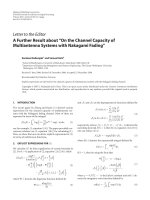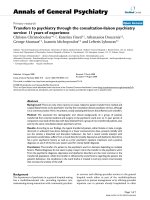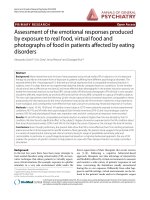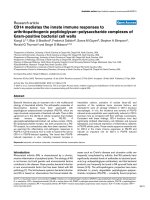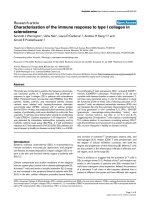Báo cáo y học: "Letter to the editor" ppsx
Bạn đang xem bản rút gọn của tài liệu. Xem và tải ngay bản đầy đủ của tài liệu tại đây (35.85 KB, 3 trang )
414
ICU = intensive care unit; LOS = length of stay.
Critical Care August 2005 Vol 9 No 4 Kanna et al.
Regarding the interesting article on early tracheostomy by
Arabi and coworkers [1] recently published in Critical Care,
we should like to offer the following comments.
There are significant differences between the two study
groups in terms of baseline characteristics. Patients with
maxillary trauma, as reported by the investigators, are usually
preselected for early tracheal intubation. This practice is
dependent on the notion that respiratory failure is due to
airway compromise rather than lung injury. The study also
reported delayed tracheostomy in patients with spinal injury
because of the need to stabilize the spine before
tracheostomy. Therefore, it will be useful to know what were
the indications for endotracheal intubation among the study
patients [2]. It would also be interesting to know what were
the weaning criteria employed in each study group before
and after tracheostomy [3].
Whether critically ill intensive care unit (ICU) patients with
medical comorbidities derive benefit from early tracheostomy,
as compared with the predominantly surgical patients
included in the study by Arabi and coworkers, remains
unknown. However, other studies have demonstrated a lack
of benefit from early tracheostomy in patients with additional
medical comorbidities [4].
Because the length of stay (LOS) in ICU was the same in
both groups after tracheostomy, we believe that the decrease
in total LOS in the early tracheostomy group cannot be
attributed to the timing of tracheostomy alone. Criteria for
transfer of patients out of the ICU to the ward are highly
variable among different institutions and depend on local
facilities and availability of staff to manage patients on
mechanical ventilation in the medical wards. Therefore,
outcome measures of overall LOS in an ICU will depend on
local facilities and practices.
Letter
Letter to the editor
Balavenkatesh Kanna
1
, Haj Asaad Ayman
2
and Anita Soni
3
1
Assistant Program Director of Internal Medicine, Lincoln Hospital, and Assistant Professor of Internal Medicine, Weill Medical College of Cornell
University, New York, New York, USA
2
Resident, Department of Internal Medicine, Lincoln Hospital, Bronx, New York, USA
3
Chief and Program Director, Lincoln Hospital, and Associate Professor of Internal Medicine, Weill Medical College of Cornell University, New York,
New York, USA
Corresponding author: Balavenkatesh Kanna,
Published online: 7 February 2005 Critical Care 2005, 9:414-416 (DOI 10.1186/cc3043)
This article is online at />© 2005 BioMed Central Ltd
Authors’ response
Yaseen Arabi, Samir Haddad, Nehad Shirawi and Abdullah Al Shimemeri
We should like to thank Dr Kanna and colleagues for their letter.
In our article [1] we addressed the issue of differences in
baseline characteristics, namely whether maxillofacial injuries
or spinal cord injuries were present. Using multivariate
analysis, we found late tracheostomy (odds ratio 6.9, 95%
confidence interval 2.6–18.1; P < 0.001) and, to a much
lesser extent, spinal cord injury (odds ratio 4.7, 95%
confidence interval 0.99–22.6; P = 0.052) to be independent
predictors of prolonged ICU stay.
As we indicated in our report, the study was based on an ICU
database, and therefore details regarding the reason for
intubation and mode of weaning were not available. However,
our trauma patients (like other trauma patients) are typically
intubated for airway protection as part of their initial
resuscitation.
The purpose of our study was to examine the impact of
tracheostomy timing in trauma patients – a population that is
typically young and free from medical comorbidities.
According to Acute Physiology and Chronic Health
Evaluation II definitions for chronic illnesses [5], there was
only one patient with chronic renal failure in the early
tracheostomy group and one patient with chronic respiratory
insufficiency in the late tracheostomy group, and no patients
415
Available online />had chronic cardiac or liver disease or immunosuppression.
Therefore, no conclusions could be drawn from our study
regarding the impact of medical comorbidities. However, we
disagree with the assertion by Kanna and colleagues that no
benefit has been demonstrated for early tracheostomy in
medical (as opposed to surgical) patients. A recent
prospective, randomized controlled trial in medical patients
found significant reductions in mortality rate, incidence of
pneumonia and LOS [6].
We were surprised by the statement by Dr Kanna and
colleagues that the ICU LOS was ‘the same in both groups’.
This was not the case because the main finding in our study
was a significant reduction in ICU LOS (10.9 ± 1.2 days for
the early tracheostomy group versus 21.0 ± 1.3 days for late
tracheostomy patients; P < 0.0001). Because our patients
were discharged at comparable periods after tracheostomy,
as shown in Table 2 of our report [1], the difference in ICU
LOS could only be explained by the reduction in
pretracheostomy duration (i.e. the timing of tracheostomy, or
days from ICU admission to tracheostomy: 4.6 ± 0.5 days
versus 14.1 ± 0.5 days; P < 0.0001).
We agree that ICU discharge practices vary among
institutions, but this is unlikely to affect the results and
implications of our study because the comparison is made
between two groups cared for in the same institution, by the
same physicians and using the same discharge practices.
Our clarification to the Author’s comments
Balavenkatesh Kanna, Haj Asaad Ayman and Anita Soni
In reply to the following comment on the length of ICU stay by
Arabi and coworkers, we would like to clarify our
interpretation of the study results.
Author’s Comment
“We were surprised by the statement by Dr Kanna and
colleagues that the ICU LOS was ‘the same in both groups’.
This was not the case because the main finding in our study
was a significant reduction in ICU LOS (10.9 ± 1.2 days for
the early tracheotomy group versus 21.0 ± 1.3 days for late
tracheotomy patients; P < 0.0001). Because our patients
were discharged at comparable periods after tracheotomy, as
shown in Table 2 of our report [1], the difference in ICU LOS
could only be explained by the reduction in pre-tracheotomy
duration (i.e. the timing of tracheotomy, or days from ICU
admission to tracheotomy: 4.6 ± 0.5 days versus
14.1 ± 0.5 days; P < 0.0001)”.
Our Clarification
The length of stay in ICU after tracheostomy was the same in
both groups.
With reference to Table 2 in the study by Arabi and
coworkers, we would like to point out that the length of stay
in ICU (ICU LOS, 10.9 ± 1.2 versus 21.0 ± 1.3) was different
in both groups due to the difference in days from ICU
admission to tracheotomy (4.6 ± 0.5 versus 14.1 ± 0.5)
rather than a difference in the days from tracheotomy to ICU
discharge (6.3 ± 1.3 versus 6.9 ± 1.1) Also, the duration of
mechanical ventilation (9.6 ± 1.2 versus 18.7 ± 1.3) was
different between both study groups due to difference
between Ventilation days before tracheotomy (4.6 ± 0.5
versus 13.9 ± 0.5) as opposed to days from tracheotomy to
weaning (4.9 ± 1.2 versus 4.9 ± 1.1).
If the days from tracheotomy to ICU discharge or days from
tracheotomy to weaning were less in the early tracheotomy
group, then one can attribute the difference in the total ICU
LOS or duration of mechanical ventilation between the two
study groups to tracheotomy alone. In this study, a significant
number of patients with maxillary trauma, low Glasgow Coma
scale score underwent early tracheotomy and those with
spinal cord injury had delayed tracheotomy. This introduces
selection bias which could partly explain the differences
among days from admission to tracheotomy and ventilation
days before tracheotomy between the study groups.
Despite limitations among studies, we appreciate the
advantages of early tracheotomy including provision of
patient comfort, secure airway, facilitation of weaning from
ventilator and improving the ability to manage ventilator-
dependent patients in non- intensive care step-down units.
[7] The observations made by Arabi and coworkers are
important in the airway management of critically ill patients.
Authors’ response
Yaseen Arabi, Samir Haddad, Nehad Shirawi and Abdullah Al Shimemeri
Dr Kanna and colleagues cite again our findings that ICU
LOS after tracheostomy was not significantly different in both
groups. We have addressed this point both in our article and
in our previous response. Our primary endpoint was “total”
ICU length of stay (ICU LOS) used as a surrogate for ICU
resource utilization. Subdividing ICU LOS is of less
importance (and is probably irrelevant) as an indicator of
resource utilization. Our study showed that early vs. late
tracheostomy was associated with a significant reduction in
the primary endpoint (ICU LOS). The points mentioned in
Dr Kanna’s second letter fully support our point that ICU LOS
was shorter in the early tracheostomy group mainly because
of differences in the timing of the procedure and not because
of its effect on weaning.
416
Critical Care August 2005 Vol 9 No 4 Kanna et al.
Additionally, the focus of our study was whether early (versus
late) tracheostomy and not tracheostomy itself (versus no
tracheostomy) shortens ICU LOS. Therefore, we are not
attributing the significant differences in ICU LOS in our study
cohort to tracheostomy but rather to timing of tracheostomy.
The issue of whether tracheostomy (versus no tracheostomy)
facilitates weaning and shortens ICU LOS was not the
objective of our study and is better resolved with different
study design. However, timing of tracheostomy may in fact
affect weaning. The lack of a significant effect in the trauma
population does not exclude such an effect in other patients’
populations. A recent retrospective cohort study on medical
ICU patients showed that tracheostomy performed after
21 days of intubation was associated with a higher rate of
failure to wean from mechanical ventilation, longer ICU stay
and higher ICU mortality [8].
Once again, we have addressed the issue of differences in
maxillofacial and spinal cord injuries using multivariate
analysis. We have shown that after adjustment to the
presence or absence of these injuries; late timing of
tracheostomy remained the most significant predictor of
prolonged ICU stay. We refer Dr Kanna to the article and to
our previous response for the values of Odds ratios and
Confidence Intervals.
Recently, we examined a cohort of 347 ICU tracheostomized
medical-surgical patients [9]. Again we found that timing of
tracheostomy was an independent predictor of ICU LOS.
The efficient use of ICU resources is focus of all ICU
administrators facing the increasing demands and financial
and staffing constraints. Our study suggests that we can
potentially reduce resource utilization without negatively
affecting patient outcomes by modifying our practices of
tracheostomy timing.
More than ever before we recognize that time is the essence
in different aspects of critical care [10]. Tracheostomy timing
is probably no exception.
Competing interests
The author(s) declare that they have no competing interests.
References
1. Arabi Y, Haddad S, Shirawi N, Al Shimemeri A: Early tra-
cheostomy in intensive care trauma patient improves
resource utilization: a cohort study and literature review. Crit
Care 2004, 8:R347-R352.
2. Dunham CM, Barraco RD, Clark DE, Daley BJ, Davis FE 3rd,
Gibbs MA, Knuth T, Letarte PB, Luchette FA, Omert L, et al.:
Guidelines for emergency tracheal intubation immediately
after traumatic injury. J Trauma 2003, 55:162-179
3. MacIntyre NR, Cook DJ, Ely EW Jr, Epstein SK, Fink JB, Heffner
JE, Hess D, Hubmayer RD, Scheinhorn DJ; American College of
Chest Physicians; American Association for Respiratory Care;
American College of Critical Care Medicine: Evidence-based
guidelines for weaning and discontinuing ventilator support: a
collective task force facilitated by the American College of
Chest Physicians; the American Association for Respiratory
Care; and the American College of Critical Care Medicine.
Chest 2001, Suppl:375S-395S.
4. Engoren M, Arslanian-Engoren C, Fenn-Buderer N: Hospital and
long-term outcome after tracheostomy for respiratory failure.
Chest 2004, 125:220-227.
5. Knaus WA, Draper EA, Wagner DP, Zimmerman JE: APACHE II:
a severity of disease classification system. Crit Care Med
1985, 13:818-829.
6. Rumbak MJ, Newton M, Truncale T, Schwartz SW, Adams JW,
Hazard PB: A prospective, randomized, study comparing early
percutaneous dilational tracheotomy to prolonged translaryn-
geal intubation (delayed tracheotomy) in critically ill medical
patients. Crit Care Med 2004, 32:1689-1694.
7. Heffner JE: The Role of Tracheotomy in Weaning. Chest 2001,
120:477S-481S.
8. Hsu CL, Chen KU, Chang CH, Jerng JS, Yu CJ, Yang PC: Timing
of tracheostomy as a determinant of weaning success in criti-
cally ill patients: a retrospective study. Crit Care 2005, 9:R46-
R52.
9. Arabi Y, Haddad S, Giridhar H: The impact of tracheostomy
timing on ICU length of stay. Crit Care Med (Suppl) 2004, 32:
A111.
10. Spivey M, Ball J: Recently published papers: The message is
clear – start early? Crit Care 2004, 8:303-305.



